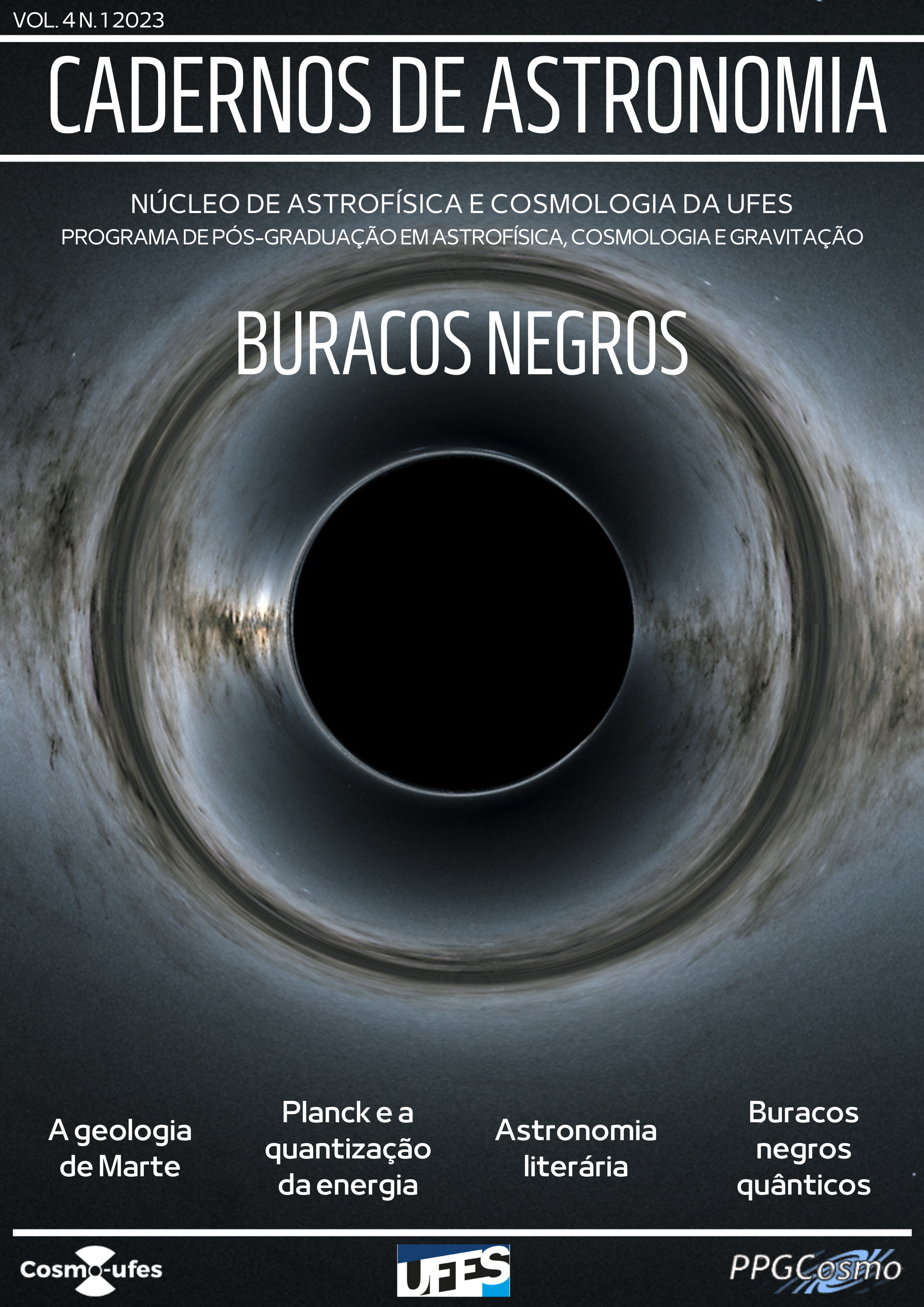Introdução aos aspectos geológicos do planeta Marte: implicações para a possibilidade de colonização humana
DOI:
https://doi.org/10.47456/Cad.Astro.v4n1.38690Palavras-chave:
geologia de Marte, planetologia comparada, colonizaçãoResumo
O presente artigo foi realizado a partir de compilação de dados pré-existentes na literatura nacional e internacional e tem como objetivo analisar e discutir as condições geológicas do planeta Marte e o seu potencial para colonização humana, trazendo informações de estudos realizados principalmente pelas sondas enviadas a Marte, realizando o mapeamento de forma geral e através de análises in situ das rochas e solos. Com base nisso, foi realizado uma planetologia comparada, entre Terra e Marte, principalmente em se tratando das análise das estruturas geológicas presentes em ambos os planetas, para determinar se houve ou possa existir água em Marte, recurso essencial para a habitação de seres humanos. Além disso, problemáticas como a ausência de um campo magnético, que pode prejudicar qualquer ser vivo devido a alta radiação solar pela qual o mesmo se encontra exposto; e das imensas tempestades de poeira, que ameaçam devastar estruturas e persistirem por semanas, fazem com que habitar Marte se torne arriscado. Foi possível determinar esses principais fatores que impedem a colonização do Planeta Vermelho, analisado as informações obtidas por sondas enviadas pela Agência Espacial Americana (NASA) e pela Agência Espacial Europeia (ESA) e propondo ideias que podem ser capazes de tornar possível a colonização marciana, como a criação de um efeito estufa, impedindo o aumento das tempestades de poeira e da inserção de uma magnetosfera artificial. Esta última se mostra como sendo a principal solução para as problemáticas abordadas. E com a criação de uma magnetosfera, possibilita que Marte fique mais similar com a Terra e mais confortável no que diz respeito à colonização, com a mais avançada tecnologia criada pelo homem até então e por maiores estudos acerca do planeta.
Referências
P. M. Branco, Magnetismo terrestre, Serviço Geológico do Brasil - CPRM (2015). Disponível em http://www.cprm.gov.br/publique/SGBDivulga/Canal-Escola/MagnetismoTerrestre-2623.html, acesso em fev. 2023.
D. Kwon, Search for life on the red planet, The Scientist (2017). Disponível em https://www.thescientist.com/features/search-forlife-on-the-red-planet-30176, acesso em fev. 2023.
R. Paoletta, O local mais controverso para o pouso de uma nova missão em marte é também o mais animador, Gizmodo UOL (2017). Disponível em https://gizmodo.uol.com.br/novorover-marte-local-para-pouso/, acesso em fev. 2023.
M. Švanda, Tajemství rudé planety: Povrchové extrémy marsových sopek a kaňonů, Što Plus Jednička. Disponível em https://www.stoplusjednicka.cz/tajemstvi-rude-planety-povrchoveextremy-marsovych-sopek-kanonu, acesso em fev. 2023.
Martian interior: paleomagnetism, European Space Agency (2019). Disponível em https://sci.esa.int/web/marsexpress/-/31028-martian-interior?section=paleomagnetism, acesso em fev. 2023.
N. Neal-Jones e C. O’Carroll, New map provides more evidence mars once like Earth, Goddard Space Flight Center – NASA (2010). Disponível em
https://www.nasa.gov/centers/goddard/news/topstory/2005/mgs_plates.html, acesso em fev. 2023.
J. Lopes, Fim do campo magnético, Super Interessante (2013). Disponível em https://super.abril.com.br/ciencia/fim-do-campo-magnetico/, acesso em fev. 2023.
O plano da nasa para transformar marte em um planeta, BBC News Brasil (2017). Disponível em https://www.bbc.com/portuguese/geral-39164794, acesso em fev. 2023.
P. R. Christensen, The many faces of mars 293(1), 32 (2005).
Pit where a scarp exposes an underground deposit of martian ice, Photojournal JPL NASA (2018). Disponível em https://mars.nasa.gov/resources/21429/pit-where-a-scarp-exposes-anunderground-deposit-of-martian-ice/, acesso em fev. 2023.
J. Parks, Massive, deep deposits of ice found on mars, Astronomy (2018). Disponível em https://astronomy.com/news/2018/01/martian-ice, acesso em fev. 2023.
R. Orosei et al., Radar evidence of subglacial liquid water on mars, Science 361(6401), 490 (2018). ArXiv:arXiv:2004.04587.
E. Veiga, Cientistas encontram água lí- quida em marte, descoberta que pode transformar busca por vida, BBC News Brasil (2018). Disponível em https://www.bbc.com/portuguese/geral-44946892, acesso em fev. 2023.
L. Xiao, Ways to Study Mars, in Mars on Earth, editado por L. Xiao (World Scientific, 2021), 1.
Very high silicon content surprises mars researchers, Niels Bohr Institute (2015). Disponível em https://nbi.ku.dk/english/news/news15/very-high-siliconcontent-surprises-mars-researchers/, acesso em fev. 2023.
Rocks rich in silica present puzzles for mars rover team, Jet Propulsion Laboratory - NASA (2015). Disponível em https://www.jpl.nasa.gov/news/rocksrich-in-silica-present-puzzles-formars-rover-team, acesso em fev. 2023.
Chemcam spectrum from Martian Rock Target ’Ithaca’, NASA Science Mars
Exploration (2013). Disponível em
https://mars.nasa.gov/resources/5763/chemcam-spectrum-from-martian-rocktarget-ithaca/, acesso em fev. 2023.
Map of martian silicon at mid-latitudes, NASA. Disponível em https://www.jpl.nasa.gov/images/pia04256-mapof-martian-silicon-at-mid-latitudes, acesso em fev. 2023.
K. Mersmann, The fact and fiction of martian dust storms, NASA (2017). Disponível em https://www.nasa.gov/feature/goddard/the-fact-and-fiction-ofmartian-dust-storms, acesso em fev. 2023.
NASA Mars Rovers Braving Severe Dust Storms, NASA. Disponível em https://www.jpl.nasa.gov/news/nasa-marsrovers-braving-severe-dust-storms, acesso em fev. 2023.
S. Sacani, Insight estudará os terremotos marcianos, Space Today (2018). Disponível em https://spacetoday.com.br/insightestudara-os-terremotos-marcianosspace-today-tv-ep-1172/, acesso em fev. 2023.
Downloads
Publicado
Edição
Seção
Licença
Copyright (c) 2023 Gisllayne Roque Silvestre

Este trabalho está licenciado sob uma licença Creative Commons Attribution 4.0 International License.






